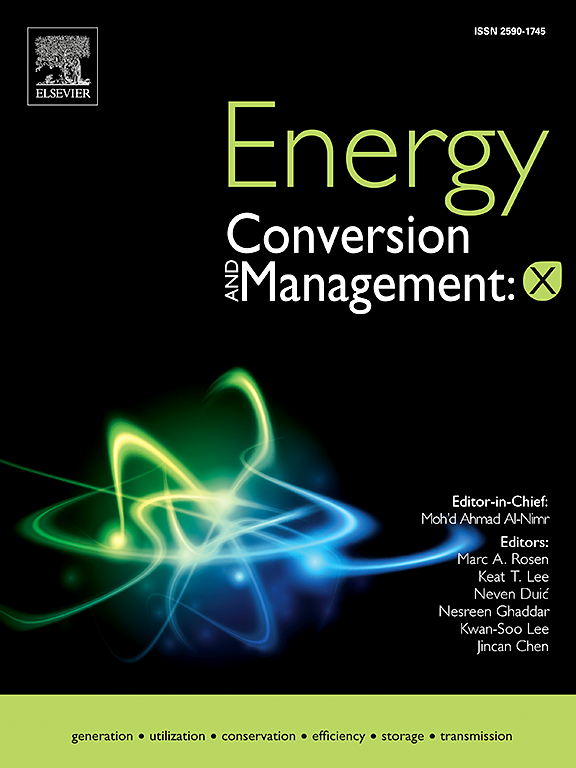基于二维三维耦合分析的水汽摆动直接空气捕获模块优化和阵列设计
IF 9.9
1区 工程技术
Q1 ENERGY & FUELS
引用次数: 0
摘要
直接空气捕获(DAC)对于抵消碳排放至关重要。湿度摆动吸附(MSA)是一种通过湿度调节在吸附和解吸之间切换的 DAC 方法,无需依赖热量,具有显著的节能潜力,但缺乏工程解决方案。因此,利用经过验证的 2D-3D 耦合模型,提出了一种湿度摆动 DAC 阵列,并通过多维评估对系统进行了优化。与燃烧后气体 90% 左右的首选捕集率不同,空气中超低的二氧化碳浓度导致 DAC 的捕集率范围不同。模拟结果表明,虽然 DAC 的捕集率可以达到 90%,但代价是能耗超过 3000 千瓦时/吨二氧化碳,且吸附剂利用率较低。因此,基于吸附剂利用率、能耗和成本分析的详细评估方法将首选捕集率范围优化为 50-60%,总能耗降至 873.55 kWh/t CO2,其中捕集能耗为 276.33 kWh/t CO2,真空浓缩能耗为 597.22 kWh/t CO2。在最佳捕集率为 53.91 % 时,最低成本为 209.17 美元/吨二氧化碳。随后,鄂尔多斯高原作为风资源丰富、气候干燥的典型优选子环境,被选中进行 DAC 系统部署研究。风场模拟确定了仅占 0.298 平方公里的万吨级阵列布局。最后,基于盛行风带来的捕集能量节省、低品位余热利用带来的再生能量节省以及吸附剂本身性能的改善,该 DAC 装置显示出巨大的潜力,可将能量和捕集成本降至 564.91 kWh/t CO2 和 140.25 美元/t CO2,当风速超过 16.8 m/s 时,该装置转为被动吸附,进一步将能耗降至 408.89 kWh/t CO2,最低固定投资估计为 2171 万美元。本文章由计算机程序翻译,如有差异,请以英文原文为准。
Module optimization and array design of moisture swing direct air capture based on 2D-3D coupled analysis
Direct Air Capture (DAC) is crucial for offsetting carbon emissions. Moisture Swing Adsorption (MSA), a DAC method switches between adsorption and desorption through humidity adjustment without relying on heat, offering significant energy-saving potential but lacking engineering solutions. Therefore, using a validated 2D-3D coupled model, a moisture swing DAC array was proposed, and multi-dimensional evaluations were used to optimize the system. Unlike the preferred capture rate around 90 % for post-combustion gas, the ultra-low CO2 concentration in the air resulted in a different rate range for DAC. Simulation indicated that although the capture rate of DAC could reach 90 %, the trade-off was energy consumption exceeding 3000 kWh/t CO2 with low adsorbent utilization. Consequently, a detailed evaluation method based on adsorbent utilization, energy consumption and cost analysis optimized the preferred capture rate range to 50–60 %, and the total energy consumption was reduced to 873.55 kWh/t CO2, including 276.33 kWh/t CO2 for capture energy and 597.22 kWh/t CO2 for vacuum-concentration energy. The lowest cost was $209.17/t CO2 at the optimal capture rate of 53.91 %. Afterwards, the Ordos Plateau, as a typical preferred sub-environment with abundant wind resources and dry climate, was choose for DAC system deployment study. Wind field simulation determined the layout of a 10000-ton array occupying only 0.298 km2. Finally, based on savings in capture energy due to prevailing winds, regeneration energy savings from the utilization of low-grade waste heat, and the improved performance of the adsorbent itself, it was found that this DAC unit showed great potential to reduce the energy and capture costs to 564.91 kWh/t CO2 and $140.25/t CO2, and at wind speed exceeding 16.8 m/s, the unit switched to passive adsorption, further reducing energy consumption to 408.89 kWh/t CO2, with the minimum fix investment estimated at 21.71 million USD.
求助全文
通过发布文献求助,成功后即可免费获取论文全文。
去求助
来源期刊

Energy Conversion and Management
工程技术-力学
CiteScore
19.00
自引率
11.50%
发文量
1304
审稿时长
17 days
期刊介绍:
The journal Energy Conversion and Management provides a forum for publishing original contributions and comprehensive technical review articles of interdisciplinary and original research on all important energy topics.
The topics considered include energy generation, utilization, conversion, storage, transmission, conservation, management and sustainability. These topics typically involve various types of energy such as mechanical, thermal, nuclear, chemical, electromagnetic, magnetic and electric. These energy types cover all known energy resources, including renewable resources (e.g., solar, bio, hydro, wind, geothermal and ocean energy), fossil fuels and nuclear resources.
 求助内容:
求助内容: 应助结果提醒方式:
应助结果提醒方式:


